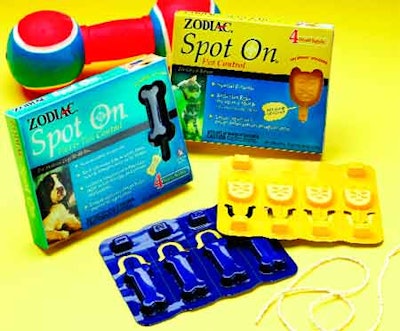Picture the predicament for the owner of both a cat and dog who’s discarded the outer carton of flea and tick treatment and is left with a primary pack that doesn’t identify if the animal health care product is for a cat or dog. The wrong product could harm Fido or Fluffy.
Schaumburg, IL-based animal care and pest control product maker Wellmark Intl. addressed that potential predicament with its February introduction of Zodiac-brand Spot On Flea & Tick topicals with Pet Specifix applicators. The thermoformed applicators are shaped like a cat’s head or a dog bone, making it easy for the owner to determine which pet the treatment is for. The outer paperboard carton includes a die-cut window, shaped just like the cat head or dog bone, that allows consumers to see the primary pack.
“Dogs and cats have different needs, especially when it comes to flea and tick control, and applying the wrong product can be harmful to a pet,” notes Dr. Jordan Siegel, Wellmark’s technical services veterinarian. “Some people are too busy to read the labels, or they simply get products confused, particularly if they have more than one dog or cat in the home.”
Zodiac’s patent-pending applicators are also color-coded to match pet weight ranges, further preventing misapplication. The Pet Specifix applicator tip is longer than a previous product applicator, making it easier for owners to apply the treatment to pets with long hair.
To use the product, the consumer breaks off one of the four doses from the perforated four-pack. One applicator is used each month. Opposite the applicator tip on each of the four doses are “lugs,” numbered one through four, that also assist users in keeping up with their pets’ monthly flea and tick treatments. The user bends back a die-cut and perforated area on the individual applicator to remove one of the four individual doses, much like a car model part might be removed from a skeletal mold. By doing this, the applicator’s tip is exposed. The user cuts the tip with a scissors and then squeezes the liquid treat ment onto the animal. The width of the tip is reduced in size from the previous pack to ease application.
Material requirements
The thermoform/fill/seal packaging line used for the primary pack was purchased in 2000 to produce its previous package. Material specifications and vendors for the new pack are considered proprietary. However, Wellmark’s Roy Brown did discuss the barrier requirements for those materials. Brown, group manager of manufacturing technology and quality, is based at the company’s Dallas manufacturing site where the Zodiac topicals are packaged.
The thermoformed primary pack contains four monthly “doses,” each divided by a perforation. “I believe we’re the only one in the market with four months of protection,” says Brown. “Most of the other over-the-counter’ [flea and tick topicals] have three months or doses.”
Brown says, “The primary requirement [for this package] was to
provide chemical barrier or resistance. We struggled to find a polymer that would give us sufficient protection to have a long shelf life,” which he estimates is at least one year. “This [structure] provides a suitable chemical barrier, and the water vapor transmission rate we need. We need to keep the chemicals in because this is a product regulated by the Environmental Protection Agency. Every batch is mixed and analyzed for active ingredients.”
Additionally, he says, “We look for barriers to water entry because it dilutes our chemical, and that [could cause the liquid product to] fall out of compliance with the EPA’s requirements.”
According to Brown, a monolayer material is used for the thermoformed base, while the lidding is a multilayer foil laminate, with no adhesive layer. “A lot of heat seals involve applying heat and pressure to melt an adhesive layer. We chose not to use the adhesive layer because it can contaminate the product. We had some struggles with getting it to seal properly. We chose to have a similar material to form out of as well as the contact layer in the foil. We melt them together to form a unified system, using heat and pressure.”
The lidding material is laser-printed inline for each of the four doses in the pack. Information includes the product name and type of pet it’s used for, a warning to keep out of reach of children, a caution to read directions before use, EPA regulations details, and contents information.
To run the new pack on the tf/f/s line Wellmark purchased for its previous pack, Brown says the company retooled its thermoforming machine, changing upper and lower portions of its forming and sealing stations, its plug-assist, and its hole punch and perforation tools. The number of packs produced across the web is considered proprietary.
Cartoning
Filled and sealed cat heads and dog bones are automatically packed into 16-pt SBS cartons from Southern Champion Tray (www.sctray.com). Brown says the cartoner was also modified for the new packs. Southern Champion uses four-color process printing on the sheet-fed press that prints the Zodiac Spot On board.
Printed copy on the board makes a reference to the unique applicator, along with a graphic of the cat head or dog bone shape with the applicator tip pointing to the die-cut window that reveals the inner thermoformed pack.
During the cartoning process at Wellmark, the thermoformed four-pack is filled into one end of the one-piece carton, on what Brown refers to as a “false back” or partition. Glued into the carton by Southern Champion, this unprinted white portion of the carton holds the thermoformed pack precisely beneath the carton’s die-cut window. Brown says that Southern Champion and Wellmark worked together to overcome the challenge it requires to position the pack in the carton.
Brown admits the new primary pack is more expensive than the version it replaced. “It’s a little larger and costs us more for the material, but we felt that it was important enough to provide to the consumer for the safety of their pets. We’ve made it simpler for the pet owner, and lessened the opportunity to misapply the product.”
Wellmark markets seven different varieties of the topicals, four for dogs, three for cats. Zodiac flea and tick topicals are sold at pet specialty stores nationwide, in prices ranging from $6.99 to $15.99, depending on the product. To date, Brown says, “market acceptance of the product has been very good.”
Consumers aren’t the only ones to take notice. In late March at the 2006 Global Pet Expo in San Diego, the American Pet Products Manufacturers Assn. and the Pet Industry Distributors Assn. jointly presented Wellmark’s parent company, Central Garden & Pet Co., with a Best in Show award for the Zodiac Cat Spot On flea and tick control with the revolutionary new shaped topical applicator.



























